Impairment Factors
VerifiedAdded on 2023/04/03
|11
|2123
|156
AI Summary
This document discusses the impairment factors affecting Leo's communication in a nursing home and provides strategies to optimize his communication access. It covers topics such as body structure and function, personal factors, environmental factors, and communication rights. The document also includes a resource on low-tech communication devices for Leo.
Contribute Materials
Your contribution can guide someone’s learning journey. Share your
documents today.

Running head: IMPAIRMENT FACTORS 1
Impairment Factors
Name
Institution
Impairment Factors
Name
Institution
Secure Best Marks with AI Grader
Need help grading? Try our AI Grader for instant feedback on your assignments.
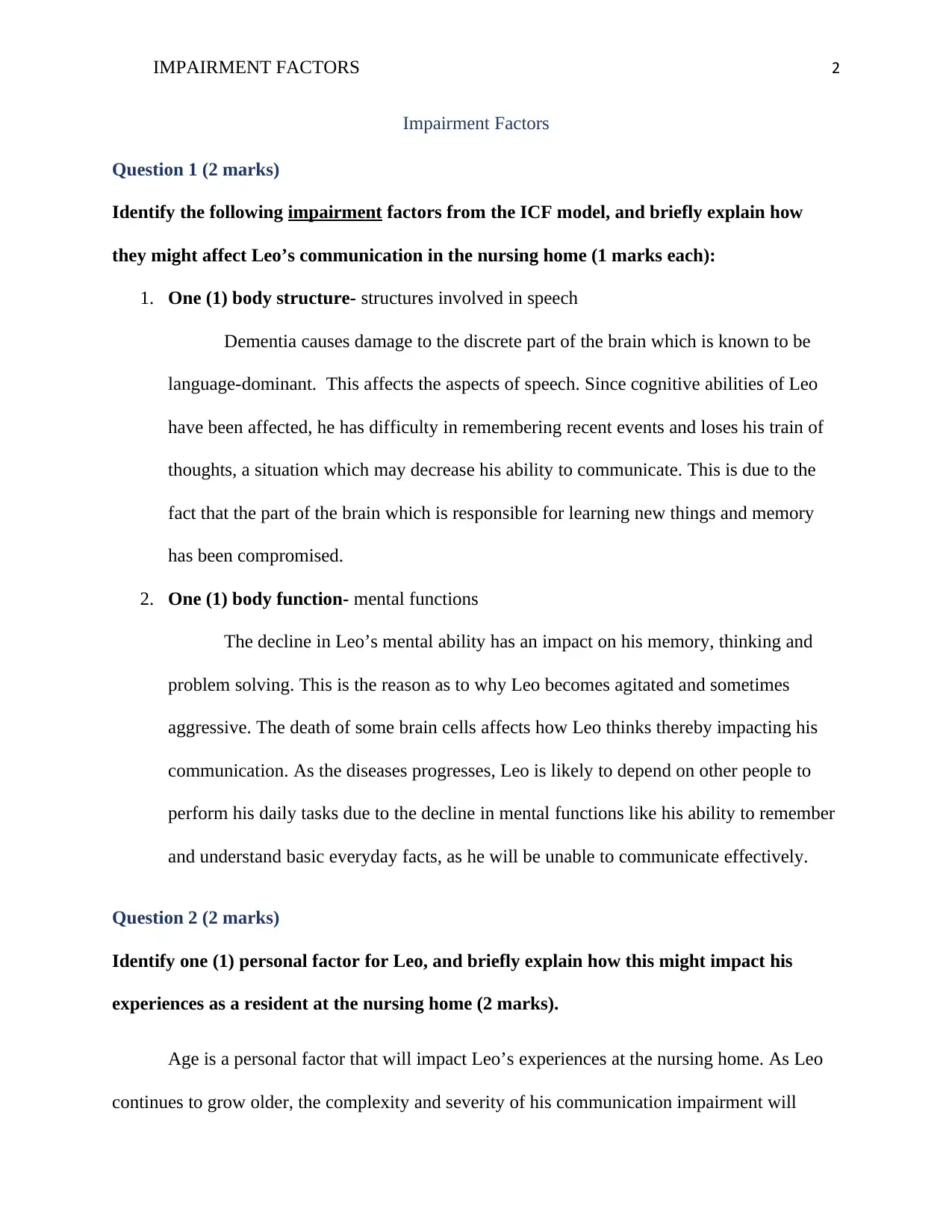
IMPAIRMENT FACTORS 2
Impairment Factors
Question 1 (2 marks)
Identify the following impairment factors from the ICF model, and briefly explain how
they might affect Leo’s communication in the nursing home (1 marks each):
1. One (1) body structure- structures involved in speech
Dementia causes damage to the discrete part of the brain which is known to be
language-dominant. This affects the aspects of speech. Since cognitive abilities of Leo
have been affected, he has difficulty in remembering recent events and loses his train of
thoughts, a situation which may decrease his ability to communicate. This is due to the
fact that the part of the brain which is responsible for learning new things and memory
has been compromised.
2. One (1) body function- mental functions
The decline in Leo’s mental ability has an impact on his memory, thinking and
problem solving. This is the reason as to why Leo becomes agitated and sometimes
aggressive. The death of some brain cells affects how Leo thinks thereby impacting his
communication. As the diseases progresses, Leo is likely to depend on other people to
perform his daily tasks due to the decline in mental functions like his ability to remember
and understand basic everyday facts, as he will be unable to communicate effectively.
Question 2 (2 marks)
Identify one (1) personal factor for Leo, and briefly explain how this might impact his
experiences as a resident at the nursing home (2 marks).
Age is a personal factor that will impact Leo’s experiences at the nursing home. As Leo
continues to grow older, the complexity and severity of his communication impairment will
Impairment Factors
Question 1 (2 marks)
Identify the following impairment factors from the ICF model, and briefly explain how
they might affect Leo’s communication in the nursing home (1 marks each):
1. One (1) body structure- structures involved in speech
Dementia causes damage to the discrete part of the brain which is known to be
language-dominant. This affects the aspects of speech. Since cognitive abilities of Leo
have been affected, he has difficulty in remembering recent events and loses his train of
thoughts, a situation which may decrease his ability to communicate. This is due to the
fact that the part of the brain which is responsible for learning new things and memory
has been compromised.
2. One (1) body function- mental functions
The decline in Leo’s mental ability has an impact on his memory, thinking and
problem solving. This is the reason as to why Leo becomes agitated and sometimes
aggressive. The death of some brain cells affects how Leo thinks thereby impacting his
communication. As the diseases progresses, Leo is likely to depend on other people to
perform his daily tasks due to the decline in mental functions like his ability to remember
and understand basic everyday facts, as he will be unable to communicate effectively.
Question 2 (2 marks)
Identify one (1) personal factor for Leo, and briefly explain how this might impact his
experiences as a resident at the nursing home (2 marks).
Age is a personal factor that will impact Leo’s experiences at the nursing home. As Leo
continues to grow older, the complexity and severity of his communication impairment will
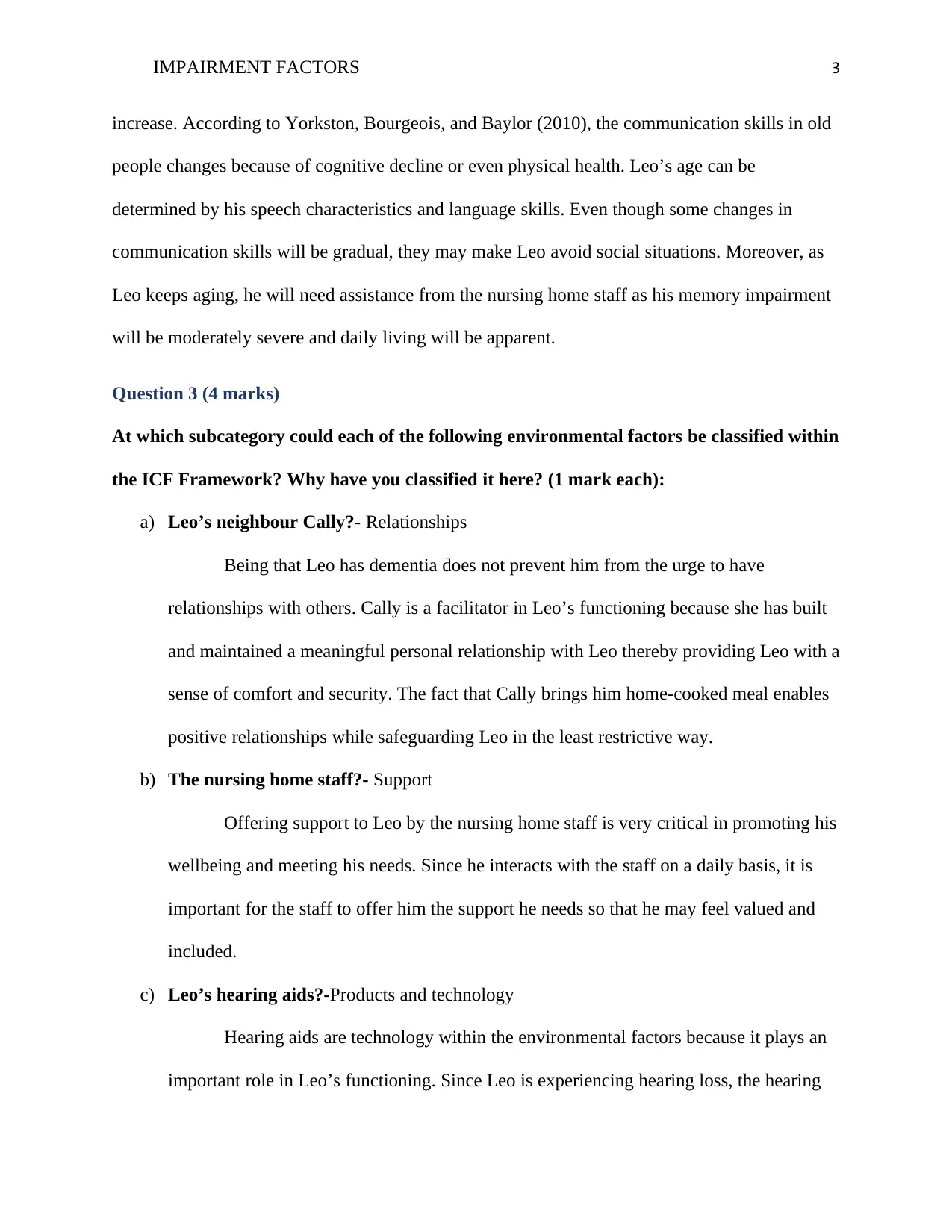
IMPAIRMENT FACTORS 3
increase. According to Yorkston, Bourgeois, and Baylor (2010), the communication skills in old
people changes because of cognitive decline or even physical health. Leo’s age can be
determined by his speech characteristics and language skills. Even though some changes in
communication skills will be gradual, they may make Leo avoid social situations. Moreover, as
Leo keeps aging, he will need assistance from the nursing home staff as his memory impairment
will be moderately severe and daily living will be apparent.
Question 3 (4 marks)
At which subcategory could each of the following environmental factors be classified within
the ICF Framework? Why have you classified it here? (1 mark each):
a) Leo’s neighbour Cally?- Relationships
Being that Leo has dementia does not prevent him from the urge to have
relationships with others. Cally is a facilitator in Leo’s functioning because she has built
and maintained a meaningful personal relationship with Leo thereby providing Leo with a
sense of comfort and security. The fact that Cally brings him home-cooked meal enables
positive relationships while safeguarding Leo in the least restrictive way.
b) The nursing home staff?- Support
Offering support to Leo by the nursing home staff is very critical in promoting his
wellbeing and meeting his needs. Since he interacts with the staff on a daily basis, it is
important for the staff to offer him the support he needs so that he may feel valued and
included.
c) Leo’s hearing aids?-Products and technology
Hearing aids are technology within the environmental factors because it plays an
important role in Leo’s functioning. Since Leo is experiencing hearing loss, the hearing
increase. According to Yorkston, Bourgeois, and Baylor (2010), the communication skills in old
people changes because of cognitive decline or even physical health. Leo’s age can be
determined by his speech characteristics and language skills. Even though some changes in
communication skills will be gradual, they may make Leo avoid social situations. Moreover, as
Leo keeps aging, he will need assistance from the nursing home staff as his memory impairment
will be moderately severe and daily living will be apparent.
Question 3 (4 marks)
At which subcategory could each of the following environmental factors be classified within
the ICF Framework? Why have you classified it here? (1 mark each):
a) Leo’s neighbour Cally?- Relationships
Being that Leo has dementia does not prevent him from the urge to have
relationships with others. Cally is a facilitator in Leo’s functioning because she has built
and maintained a meaningful personal relationship with Leo thereby providing Leo with a
sense of comfort and security. The fact that Cally brings him home-cooked meal enables
positive relationships while safeguarding Leo in the least restrictive way.
b) The nursing home staff?- Support
Offering support to Leo by the nursing home staff is very critical in promoting his
wellbeing and meeting his needs. Since he interacts with the staff on a daily basis, it is
important for the staff to offer him the support he needs so that he may feel valued and
included.
c) Leo’s hearing aids?-Products and technology
Hearing aids are technology within the environmental factors because it plays an
important role in Leo’s functioning. Since Leo is experiencing hearing loss, the hearing
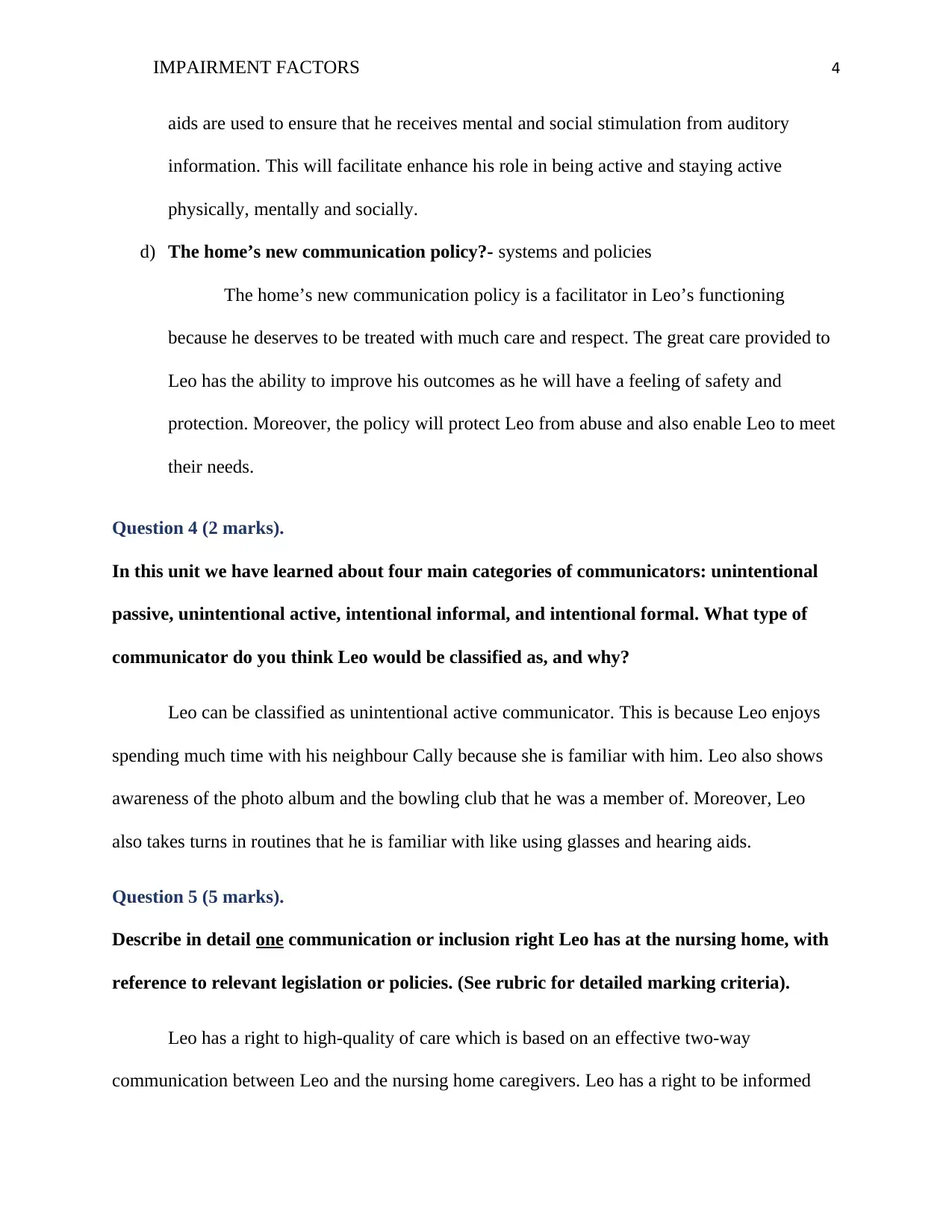
IMPAIRMENT FACTORS 4
aids are used to ensure that he receives mental and social stimulation from auditory
information. This will facilitate enhance his role in being active and staying active
physically, mentally and socially.
d) The home’s new communication policy?- systems and policies
The home’s new communication policy is a facilitator in Leo’s functioning
because he deserves to be treated with much care and respect. The great care provided to
Leo has the ability to improve his outcomes as he will have a feeling of safety and
protection. Moreover, the policy will protect Leo from abuse and also enable Leo to meet
their needs.
Question 4 (2 marks).
In this unit we have learned about four main categories of communicators: unintentional
passive, unintentional active, intentional informal, and intentional formal. What type of
communicator do you think Leo would be classified as, and why?
Leo can be classified as unintentional active communicator. This is because Leo enjoys
spending much time with his neighbour Cally because she is familiar with him. Leo also shows
awareness of the photo album and the bowling club that he was a member of. Moreover, Leo
also takes turns in routines that he is familiar with like using glasses and hearing aids.
Question 5 (5 marks).
Describe in detail one communication or inclusion right Leo has at the nursing home, with
reference to relevant legislation or policies. (See rubric for detailed marking criteria).
Leo has a right to high-quality of care which is based on an effective two-way
communication between Leo and the nursing home caregivers. Leo has a right to be informed
aids are used to ensure that he receives mental and social stimulation from auditory
information. This will facilitate enhance his role in being active and staying active
physically, mentally and socially.
d) The home’s new communication policy?- systems and policies
The home’s new communication policy is a facilitator in Leo’s functioning
because he deserves to be treated with much care and respect. The great care provided to
Leo has the ability to improve his outcomes as he will have a feeling of safety and
protection. Moreover, the policy will protect Leo from abuse and also enable Leo to meet
their needs.
Question 4 (2 marks).
In this unit we have learned about four main categories of communicators: unintentional
passive, unintentional active, intentional informal, and intentional formal. What type of
communicator do you think Leo would be classified as, and why?
Leo can be classified as unintentional active communicator. This is because Leo enjoys
spending much time with his neighbour Cally because she is familiar with him. Leo also shows
awareness of the photo album and the bowling club that he was a member of. Moreover, Leo
also takes turns in routines that he is familiar with like using glasses and hearing aids.
Question 5 (5 marks).
Describe in detail one communication or inclusion right Leo has at the nursing home, with
reference to relevant legislation or policies. (See rubric for detailed marking criteria).
Leo has a right to high-quality of care which is based on an effective two-way
communication between Leo and the nursing home caregivers. Leo has a right to be informed
Secure Best Marks with AI Grader
Need help grading? Try our AI Grader for instant feedback on your assignments.
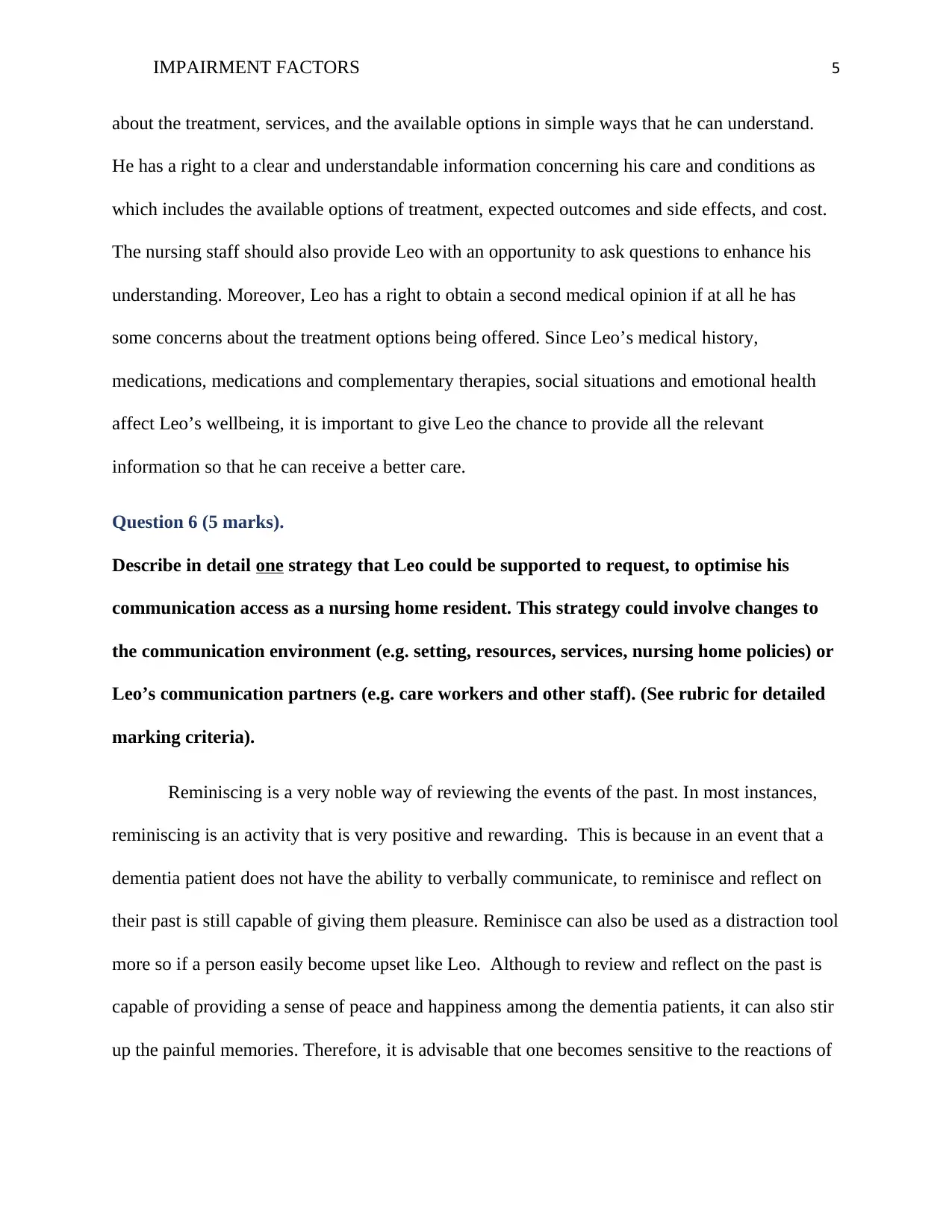
IMPAIRMENT FACTORS 5
about the treatment, services, and the available options in simple ways that he can understand.
He has a right to a clear and understandable information concerning his care and conditions as
which includes the available options of treatment, expected outcomes and side effects, and cost.
The nursing staff should also provide Leo with an opportunity to ask questions to enhance his
understanding. Moreover, Leo has a right to obtain a second medical opinion if at all he has
some concerns about the treatment options being offered. Since Leo’s medical history,
medications, medications and complementary therapies, social situations and emotional health
affect Leo’s wellbeing, it is important to give Leo the chance to provide all the relevant
information so that he can receive a better care.
Question 6 (5 marks).
Describe in detail one strategy that Leo could be supported to request, to optimise his
communication access as a nursing home resident. This strategy could involve changes to
the communication environment (e.g. setting, resources, services, nursing home policies) or
Leo’s communication partners (e.g. care workers and other staff). (See rubric for detailed
marking criteria).
Reminiscing is a very noble way of reviewing the events of the past. In most instances,
reminiscing is an activity that is very positive and rewarding. This is because in an event that a
dementia patient does not have the ability to verbally communicate, to reminisce and reflect on
their past is still capable of giving them pleasure. Reminisce can also be used as a distraction tool
more so if a person easily become upset like Leo. Although to review and reflect on the past is
capable of providing a sense of peace and happiness among the dementia patients, it can also stir
up the painful memories. Therefore, it is advisable that one becomes sensitive to the reactions of
about the treatment, services, and the available options in simple ways that he can understand.
He has a right to a clear and understandable information concerning his care and conditions as
which includes the available options of treatment, expected outcomes and side effects, and cost.
The nursing staff should also provide Leo with an opportunity to ask questions to enhance his
understanding. Moreover, Leo has a right to obtain a second medical opinion if at all he has
some concerns about the treatment options being offered. Since Leo’s medical history,
medications, medications and complementary therapies, social situations and emotional health
affect Leo’s wellbeing, it is important to give Leo the chance to provide all the relevant
information so that he can receive a better care.
Question 6 (5 marks).
Describe in detail one strategy that Leo could be supported to request, to optimise his
communication access as a nursing home resident. This strategy could involve changes to
the communication environment (e.g. setting, resources, services, nursing home policies) or
Leo’s communication partners (e.g. care workers and other staff). (See rubric for detailed
marking criteria).
Reminiscing is a very noble way of reviewing the events of the past. In most instances,
reminiscing is an activity that is very positive and rewarding. This is because in an event that a
dementia patient does not have the ability to verbally communicate, to reminisce and reflect on
their past is still capable of giving them pleasure. Reminisce can also be used as a distraction tool
more so if a person easily become upset like Leo. Although to review and reflect on the past is
capable of providing a sense of peace and happiness among the dementia patients, it can also stir
up the painful memories. Therefore, it is advisable that one becomes sensitive to the reactions of
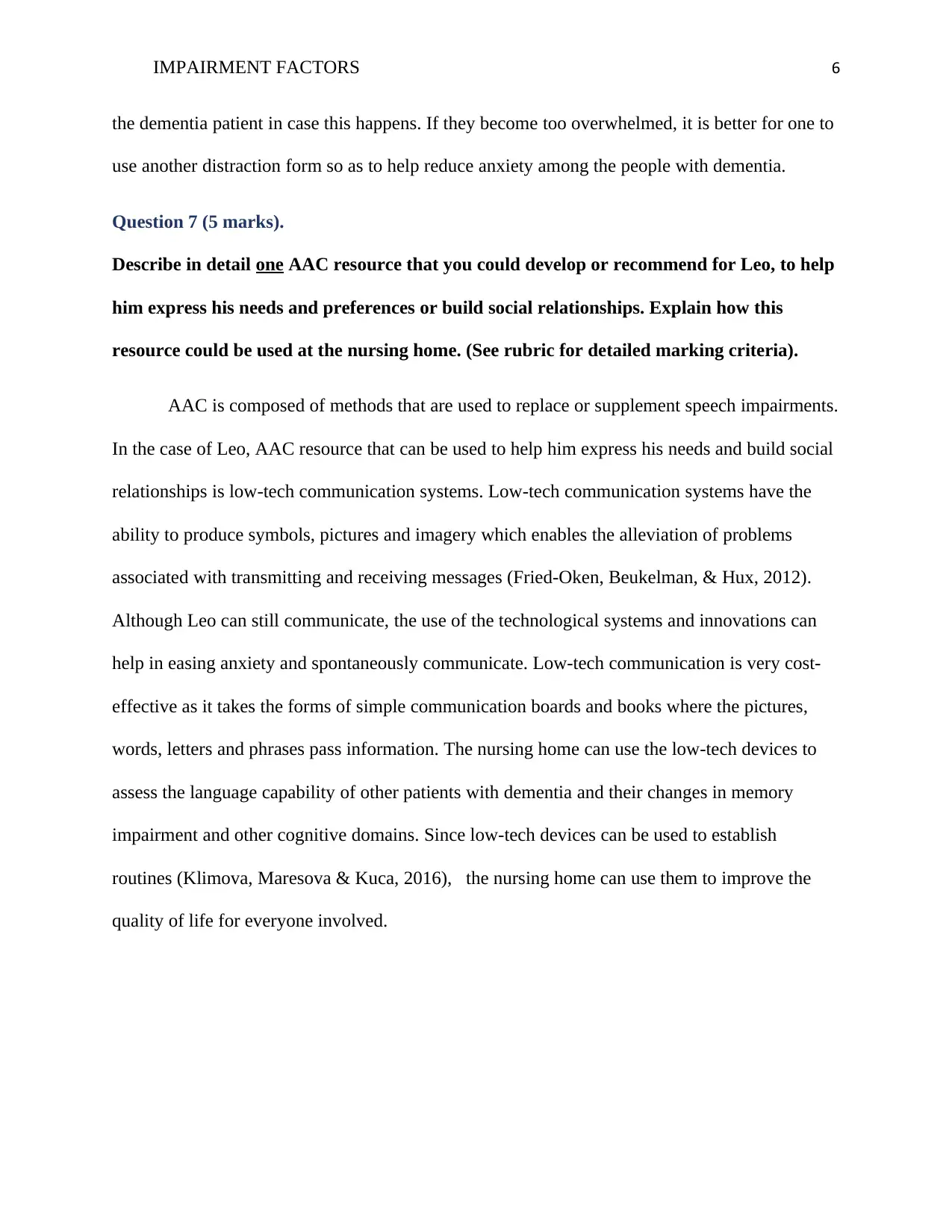
IMPAIRMENT FACTORS 6
the dementia patient in case this happens. If they become too overwhelmed, it is better for one to
use another distraction form so as to help reduce anxiety among the people with dementia.
Question 7 (5 marks).
Describe in detail one AAC resource that you could develop or recommend for Leo, to help
him express his needs and preferences or build social relationships. Explain how this
resource could be used at the nursing home. (See rubric for detailed marking criteria).
AAC is composed of methods that are used to replace or supplement speech impairments.
In the case of Leo, AAC resource that can be used to help him express his needs and build social
relationships is low-tech communication systems. Low-tech communication systems have the
ability to produce symbols, pictures and imagery which enables the alleviation of problems
associated with transmitting and receiving messages (Fried-Oken, Beukelman, & Hux, 2012).
Although Leo can still communicate, the use of the technological systems and innovations can
help in easing anxiety and spontaneously communicate. Low-tech communication is very cost-
effective as it takes the forms of simple communication boards and books where the pictures,
words, letters and phrases pass information. The nursing home can use the low-tech devices to
assess the language capability of other patients with dementia and their changes in memory
impairment and other cognitive domains. Since low-tech devices can be used to establish
routines (Klimova, Maresova & Kuca, 2016), the nursing home can use them to improve the
quality of life for everyone involved.
the dementia patient in case this happens. If they become too overwhelmed, it is better for one to
use another distraction form so as to help reduce anxiety among the people with dementia.
Question 7 (5 marks).
Describe in detail one AAC resource that you could develop or recommend for Leo, to help
him express his needs and preferences or build social relationships. Explain how this
resource could be used at the nursing home. (See rubric for detailed marking criteria).
AAC is composed of methods that are used to replace or supplement speech impairments.
In the case of Leo, AAC resource that can be used to help him express his needs and build social
relationships is low-tech communication systems. Low-tech communication systems have the
ability to produce symbols, pictures and imagery which enables the alleviation of problems
associated with transmitting and receiving messages (Fried-Oken, Beukelman, & Hux, 2012).
Although Leo can still communicate, the use of the technological systems and innovations can
help in easing anxiety and spontaneously communicate. Low-tech communication is very cost-
effective as it takes the forms of simple communication boards and books where the pictures,
words, letters and phrases pass information. The nursing home can use the low-tech devices to
assess the language capability of other patients with dementia and their changes in memory
impairment and other cognitive domains. Since low-tech devices can be used to establish
routines (Klimova, Maresova & Kuca, 2016), the nursing home can use them to improve the
quality of life for everyone involved.

IMPAIRMENT FACTORS 7
Part B: Accessible Information Resource
Part B contains two components: an accessible resource, and a justification for the design
of this resource.
https://www.youtube.com/watch?v=5nHSqF1lnj0
Accessible Resource (10 marks)
Produce an accessible information resource for Leo, to explain ONE of the following:
1. A communication access strategy that Leo could ask the nursing home staff to
implement
Leo can ask the nursing home to implement low-tech communication devices as they also
involve recorded speech devices. Low tech devices are easy to use and set up, augment speech
and can be used as Leo is still learning high-tech devices. According to Klimova et al. (2016),
low tech are relatively faster and efficient as Leo will be able to physically use a laser, and core
vocabulary board. Moreover, low-tech devices ensure interdependence and human connection as
it engages communication partners. According to Bourgeois, Fried-Oken, and Rowland (2010),
low-tech devices are capable of supporting memory and conversation for people with dementia
by reducing the behavioral disturbances. Moreover, low-tech devices have distinctive symbol-
based systems which will allow Leo to communicate at a greater range of concepts. Iacono,
Lyon, Johnson, and West (2013) argue that low-tech devices are physically easier to use and can
be more engaging. Moreover, Leo will be able to interactively make selections from the
displayed symbols or pictures. Low-tech will also enable Leo to grow his confidence and
independence.
Part B: Accessible Information Resource
Part B contains two components: an accessible resource, and a justification for the design
of this resource.
https://www.youtube.com/watch?v=5nHSqF1lnj0
Accessible Resource (10 marks)
Produce an accessible information resource for Leo, to explain ONE of the following:
1. A communication access strategy that Leo could ask the nursing home staff to
implement
Leo can ask the nursing home to implement low-tech communication devices as they also
involve recorded speech devices. Low tech devices are easy to use and set up, augment speech
and can be used as Leo is still learning high-tech devices. According to Klimova et al. (2016),
low tech are relatively faster and efficient as Leo will be able to physically use a laser, and core
vocabulary board. Moreover, low-tech devices ensure interdependence and human connection as
it engages communication partners. According to Bourgeois, Fried-Oken, and Rowland (2010),
low-tech devices are capable of supporting memory and conversation for people with dementia
by reducing the behavioral disturbances. Moreover, low-tech devices have distinctive symbol-
based systems which will allow Leo to communicate at a greater range of concepts. Iacono,
Lyon, Johnson, and West (2013) argue that low-tech devices are physically easier to use and can
be more engaging. Moreover, Leo will be able to interactively make selections from the
displayed symbols or pictures. Low-tech will also enable Leo to grow his confidence and
independence.
Paraphrase This Document
Need a fresh take? Get an instant paraphrase of this document with our AI Paraphraser

IMPAIRMENT FACTORS 8
Resource Justification (10 marks)
Identify at least one impairment factor (body structure or function) and at least one
personal or environmental factor that could impact Leo’s access to information as a
nursing home resident. Explain how you have addressed these factors in your resource, and
justify your choices with reference to relevant evidence.
Personal factors-age
Body function-Voice and speech function
Justification
The use of Blissymbol has distinctive features which makes it preferable to people with
dementia. According to Lesser and Milroy (2014), Blissymbol has a generative system which
are interpretable by the receiver. It also has letters which are used to create words and sounds.
Blissymbol addresses body function of voice and speech function by providing a system that
contains large and flexible vocabularies which has logical rules for the expansion of grammar
and vocabulary. Rajaram, Alant, and Dada (2012) argue that Blissymbol can be used even
without generating speech. Leo can use Blissymbol to communicate with other people in the
event he gets stuck. Although Leo can still speak, the use of Blissymbol will complement his
speech. In the event that Leo will no longer be able to generate speech, Blissymbol will still
enable him to communicate. This is because Blissymbol can be used to compose a complete
sentence which makes sense. The use of Blissymbol also addresses Leo’s age as a personal factor
that can hinder Leo’s access to communication by using simple shapes to keep the symbols to
understand and remember. Since Leo’s age may affect how he functions, Blissymbol will still be
highly effective because it presents both abstract and concrete concept levels. Research
Resource Justification (10 marks)
Identify at least one impairment factor (body structure or function) and at least one
personal or environmental factor that could impact Leo’s access to information as a
nursing home resident. Explain how you have addressed these factors in your resource, and
justify your choices with reference to relevant evidence.
Personal factors-age
Body function-Voice and speech function
Justification
The use of Blissymbol has distinctive features which makes it preferable to people with
dementia. According to Lesser and Milroy (2014), Blissymbol has a generative system which
are interpretable by the receiver. It also has letters which are used to create words and sounds.
Blissymbol addresses body function of voice and speech function by providing a system that
contains large and flexible vocabularies which has logical rules for the expansion of grammar
and vocabulary. Rajaram, Alant, and Dada (2012) argue that Blissymbol can be used even
without generating speech. Leo can use Blissymbol to communicate with other people in the
event he gets stuck. Although Leo can still speak, the use of Blissymbol will complement his
speech. In the event that Leo will no longer be able to generate speech, Blissymbol will still
enable him to communicate. This is because Blissymbol can be used to compose a complete
sentence which makes sense. The use of Blissymbol also addresses Leo’s age as a personal factor
that can hinder Leo’s access to communication by using simple shapes to keep the symbols to
understand and remember. Since Leo’s age may affect how he functions, Blissymbol will still be
highly effective because it presents both abstract and concrete concept levels. Research

IMPAIRMENT FACTORS 9
conducted by O'Donnell, Bruce, Black and Clayton (2010) found that people with dementia have
the ability to solve problems using bliss symbols despite cognitive decline.
conducted by O'Donnell, Bruce, Black and Clayton (2010) found that people with dementia have
the ability to solve problems using bliss symbols despite cognitive decline.
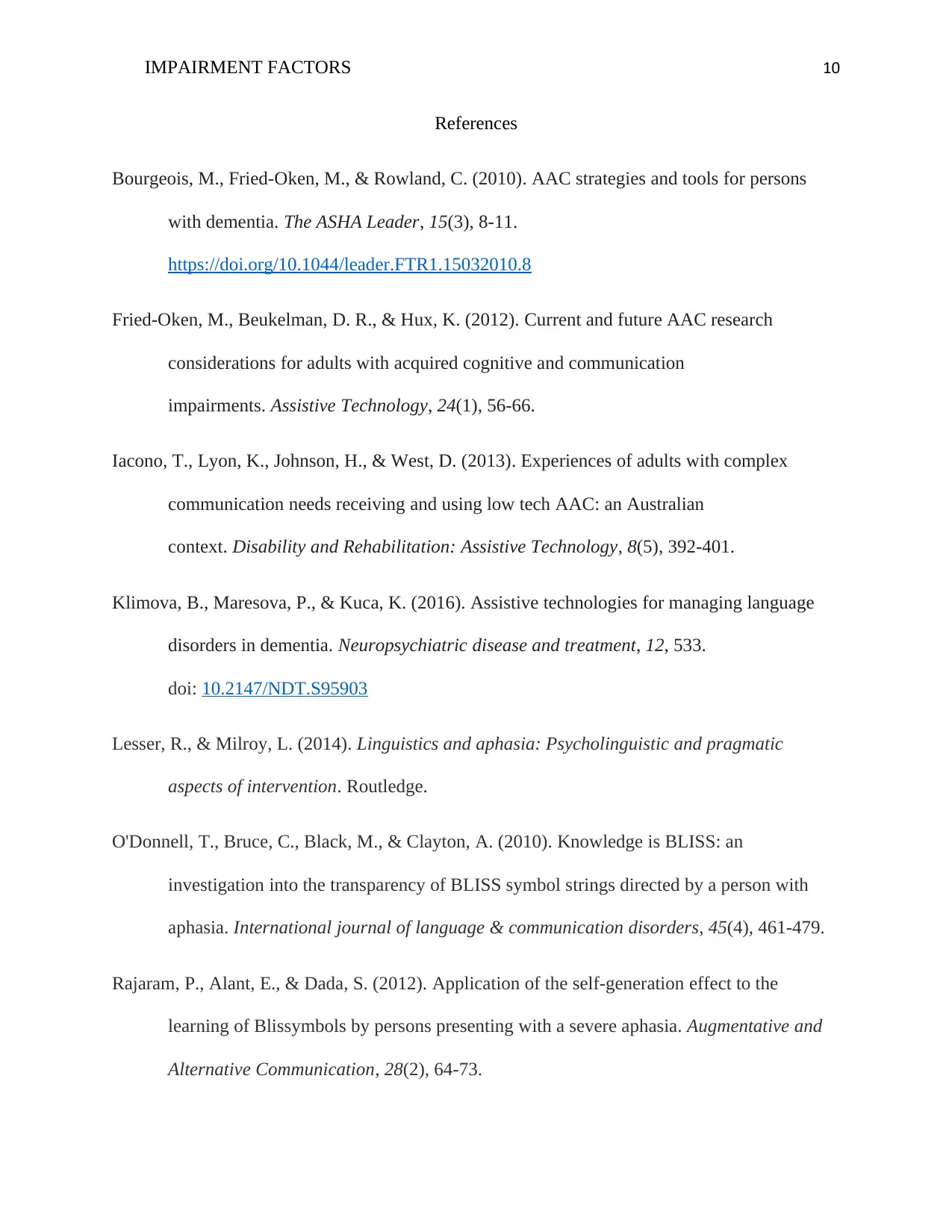
IMPAIRMENT FACTORS 10
References
Bourgeois, M., Fried-Oken, M., & Rowland, C. (2010). AAC strategies and tools for persons
with dementia. The ASHA Leader, 15(3), 8-11.
https://doi.org/10.1044/leader.FTR1.15032010.8
Fried-Oken, M., Beukelman, D. R., & Hux, K. (2012). Current and future AAC research
considerations for adults with acquired cognitive and communication
impairments. Assistive Technology, 24(1), 56-66.
Iacono, T., Lyon, K., Johnson, H., & West, D. (2013). Experiences of adults with complex
communication needs receiving and using low tech AAC: an Australian
context. Disability and Rehabilitation: Assistive Technology, 8(5), 392-401.
Klimova, B., Maresova, P., & Kuca, K. (2016). Assistive technologies for managing language
disorders in dementia. Neuropsychiatric disease and treatment, 12, 533.
doi: 10.2147/NDT.S95903
Lesser, R., & Milroy, L. (2014). Linguistics and aphasia: Psycholinguistic and pragmatic
aspects of intervention. Routledge.
O'Donnell, T., Bruce, C., Black, M., & Clayton, A. (2010). Knowledge is BLISS: an
investigation into the transparency of BLISS symbol strings directed by a person with
aphasia. International journal of language & communication disorders, 45(4), 461-479.
Rajaram, P., Alant, E., & Dada, S. (2012). Application of the self-generation effect to the
learning of Blissymbols by persons presenting with a severe aphasia. Augmentative and
Alternative Communication, 28(2), 64-73.
References
Bourgeois, M., Fried-Oken, M., & Rowland, C. (2010). AAC strategies and tools for persons
with dementia. The ASHA Leader, 15(3), 8-11.
https://doi.org/10.1044/leader.FTR1.15032010.8
Fried-Oken, M., Beukelman, D. R., & Hux, K. (2012). Current and future AAC research
considerations for adults with acquired cognitive and communication
impairments. Assistive Technology, 24(1), 56-66.
Iacono, T., Lyon, K., Johnson, H., & West, D. (2013). Experiences of adults with complex
communication needs receiving and using low tech AAC: an Australian
context. Disability and Rehabilitation: Assistive Technology, 8(5), 392-401.
Klimova, B., Maresova, P., & Kuca, K. (2016). Assistive technologies for managing language
disorders in dementia. Neuropsychiatric disease and treatment, 12, 533.
doi: 10.2147/NDT.S95903
Lesser, R., & Milroy, L. (2014). Linguistics and aphasia: Psycholinguistic and pragmatic
aspects of intervention. Routledge.
O'Donnell, T., Bruce, C., Black, M., & Clayton, A. (2010). Knowledge is BLISS: an
investigation into the transparency of BLISS symbol strings directed by a person with
aphasia. International journal of language & communication disorders, 45(4), 461-479.
Rajaram, P., Alant, E., & Dada, S. (2012). Application of the self-generation effect to the
learning of Blissymbols by persons presenting with a severe aphasia. Augmentative and
Alternative Communication, 28(2), 64-73.
Secure Best Marks with AI Grader
Need help grading? Try our AI Grader for instant feedback on your assignments.

IMPAIRMENT FACTORS 11
Yorkston, K. M., Bourgeois, M. S., & Baylor, C. R. (2010). Communication and aging. Physical
medicine and rehabilitation clinics of North America, 21(2), 309–319.
doi:10.1016/j.pmr.2009.12.011
Yorkston, K. M., Bourgeois, M. S., & Baylor, C. R. (2010). Communication and aging. Physical
medicine and rehabilitation clinics of North America, 21(2), 309–319.
doi:10.1016/j.pmr.2009.12.011
1 out of 11
Related Documents
Your All-in-One AI-Powered Toolkit for Academic Success.
+13062052269
info@desklib.com
Available 24*7 on WhatsApp / Email
![[object Object]](/_next/static/media/star-bottom.7253800d.svg)
Unlock your academic potential
© 2024 | Zucol Services PVT LTD | All rights reserved.





